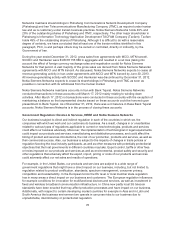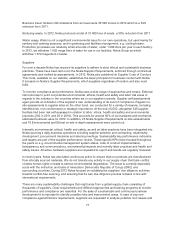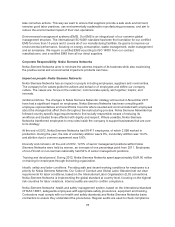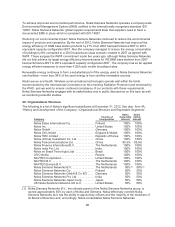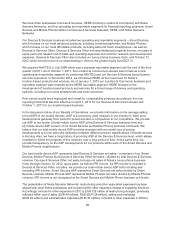Nokia 2012 Annual Report Download - page 80
Download and view the complete annual report
Please find page 80 of the 2012 Nokia annual report below. You can navigate through the pages in the report by either clicking on the pages listed below, or by using the keyword search tool below to find specific information within the annual report.Nokia Siemens Networks Code of Conduct. The Code of Conduct sets out Nokia Siemens Networks’
commitment to uphold high ethical standards wherever it operates. Nokia Siemens Networks trains its
employees on ethical business conduct every year and concerns can be reported anonymously. Any
reported ethical concerns are investigated thoroughly by Nokia Siemens Networks’ Ethics and
Compliance Office. In 2012, 86% of employees completed ethical business conduct training and 74%
of employees that work with customers and suppliers received further training on anti-corruption.
Community
Nokia Siemens Networks’ community strategy focuses on three key areas where it believes it can have
the greatest impact: first; education and ICT, second; disaster preparedness and relief and third; the
environment. Nokia Siemens Networks has policies in place relating to disaster relief and to employee
volunteering. During 2012 its efforts were focused on restructuring and internal activities.
Human rights
Nokia Siemens Networks recognizes its responsibility to help ensure that the communications
technologies it provides are used to respect, and not infringe, human rights. Nokia Siemens Networks’
Code of Conduct spells out the company’s zero tolerance for the violation of human rights. This
commitment is reinforced in its human rights policy, which establishes due diligence processes to
identify and address relevant human rights risks across the company’s global operations. Employees
are trained on human rights through ethical business training and those in high-risk roles such as
procurement are given additional training on the company’s human rights policy.
Suppliers: All suppliers must meet Nokia Siemens Networks’ global supplier requirements, which set
standards for the management of ethical, environmental and social issues. This commitment is part of
contractual agreements with suppliers. In 2012 Nokia Siemens Networks rolled out revised supplier
requirements including additional points on human rights and conflict minerals. Compliance with global
supplier requirements is monitored through system audits, of which 57 were conducted in 2012.
More detailed audits focusing on social and environmental issues are undertaken with some suppliers,
selected through a risk assessment process. Nokia Siemens Networks’ focus in 2012 was on working
closely with suppliers to bring them up to our standards and closing open audits from previous years.
Nokia Siemens Networks closed 20 in-depth audits and conducted two new additional audits.
Nokia Siemens Networks’ updated supplier requirements clearly state its policy on conflict minerals
and the company does not accept their use in our products. Nokia Siemens Networks requires
suppliers who manufacture components containing metals associated with conflict minerals to adopt a
zero tolerance policy with their respective suppliers. In 2012, Nokia Siemens Networks approached
125 key suppliers for due diligence as part of its involvement in the EICC/GeSI Extractives Working
Group’s ‘Conflict Free Smelters’ program, and completed due diligence with 40 suppliers.
Impact on the Environment: Nokia Siemens Networks
Environmental strategy. Nokia Siemens Networks’ environmental strategy has two key elements:
• Designing products and services that help telecoms operators reduce the environmental
impact of their networks; and
• Ensuring maximized efficiency in the company’s own operations to minimize our
environmental impact.
Nokia Siemens Networks offers a comprehensive range of energy solutions for telecoms operators,
combining products and services. The portfolio is designed to reduce the network operating costs of
new and legacy telecommunications networks, using more efficient technology and renewable energy
to reduce power consumption and the resultant GHG (greenhouse gas) emissions.
79



